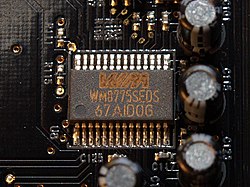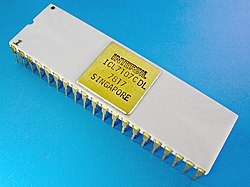
Back مبدل تماثلي رقمي Arabic Analoq-rəqəmsal çevirici Azerbaijani Аналага-лічбавы пераўтваральнік Byelorussian Аналогово-цифров преобразувател Bulgarian Convertidor analògic-digital Catalan A/D převodník Czech Analog-til-digital-konverter Danish Analog-Digital-Umsetzer German Conversión analógica-digital Spanish Analoog-digitaalmuundur Estonian





In electronics, an analog-to-digital converter (ADC, A/D, or A-to-D) is a system that converts an analog signal, such as a sound picked up by a microphone or light entering a digital camera, into a digital signal. An ADC may also provide an isolated measurement such as an electronic device that converts an analog input voltage or current to a digital number representing the magnitude of the voltage or current. Typically the digital output is a two's complement binary number that is proportional to the input, but there are other possibilities.
There are several ADC architectures. Due to the complexity and the need for precisely matched components, all but the most specialized ADCs are implemented as integrated circuits (ICs). These typically take the form of metal–oxide–semiconductor (MOS) mixed-signal integrated circuit chips that integrate both analog and digital circuits.
A digital-to-analog converter (DAC) performs the reverse function; it converts a digital signal into an analog signal.